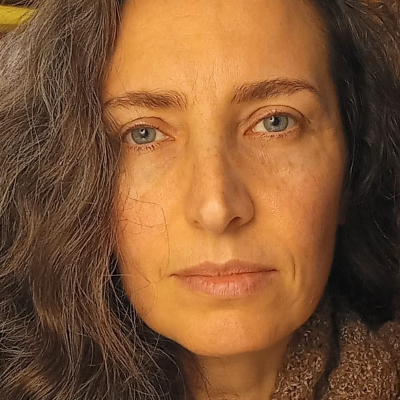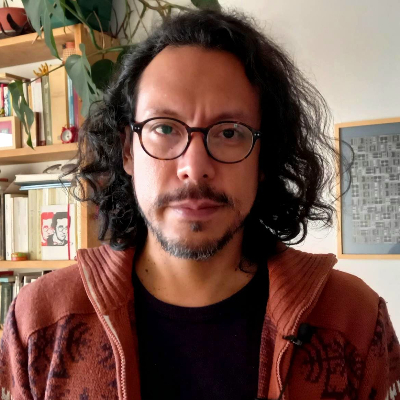“Cajas is a book about sense—one that resembles the kind of linguistic analysis that has always attracted Montalbetti. Starting from the metaphor of language as a box (una caja), he illustrates his theory on the internal mechanisms of language in general through a distillation into artistic language.”
Mario Montalbetti presents himself as a linguist who writes poems. His poetry examines the possibilities of language more than the interests of literature; his body of work is thus centered on “what language does with us and what we do to it.” He is engaged, in turn, in university education, which is reflected in his pursuit of clear reasoning. A professor, a linguist, and a poet, he works with language as object and as raw material. In Cajas (2018), these three aspects come together.
In this essay, we propose a rereading of Cajas and seek an intersection between this book’s central idea and poetry. Following the author, reading implies thinking, and thought emerges from the way words relate to one another. This idea—along with others put forward in his essays, lectures, and interviews—will serve as our guiding light.
What is Cajas? An essay in verse? A poem? A linguistics class? In the first place, it is an unclassifiable artifact that responds to the interdisciplinary nature of the author’s work: “It is, almost, not a book, […] it is an examination of sense, which resembles a book of philosophy, resembles a book of linguistics, resembles a book of poetry.” Its structure combines poetry and the essay. On the one hand, the essay allows for “that almost syllogistic sort of reasoning, with an argument that moves and leads us onward,” while, on the other hand, the poem offers “interruption, caesura, the idea that a line can be cut off to continue in the following line,” and, just as the author probes in this book, “a discrepancy between sound and meaning.” It is no coincidence that he should present his thought as a long poem.
Cajas is a book about sense—one that resembles the kind of linguistic analysis that has always attracted Montalbetti. Starting from the metaphor of language as a box (una caja), he illustrates his theory on the internal mechanisms of language in general through a distillation into artistic language. In this context, he undertakes a “most subjective and personal reading of Lacan,” as well as Adorno, Pierce, and Saussure, among others, whose ideas he will continue to explore and develop throughout his body of work. At the start, in place of the word, we find a closed cardboard box, opaque and three-dimensional (3D), which distinguishes the inside from the outside, promising to store within itself something that remains out of sight. Montalbetti calls this something his “object of promise.” This is not an object in and of itself, which may or may not be within the box; it is, rather, a formal category located within a logical space that is, by definition, hidden. It is that which “we think / believe there is within” the word.
Words promise meaning: “The venerable name of the object of promise of a word considered a 3D box.” Meanings “are not the words that appear to the right of a lexical entry in a dictionary. The definition of a word is simply a heap of signifiers.” The signifier, in turn, is “a sensory mark (or its imprint) with two properties: (a) it means nothing and (b) it produces an (effect of) meaning. The first property ensures that the signifier is not what it signifies; the second ensures that, nonetheless, the former produces the latter.” Thus, the signified is the result of a process: the effects of the signifier.
Next, once it has been opened, disassembled, and unfolded on the tabletop, we find before ourselves a 2D box. The object of promise is now on the outside. One example of this box is the photograph that, as the writer indicates, “(as an icon) promises a referent, that is, the object photographed.” Nonetheless, this is not the object of promise, but rather the object in and of itself. Here, the linguist returns to Pierce’s definition of the sign to say it is “something that is in something’s place for someone in some respect or capacity.” Based on this idea, he indicates that the box is that first “something,” while the second is the object of promise. The mechanisms of representation carry out the displacement: “To represent is to promise something on the outside.” But the 3D box, as well as the 2D box, work as signs: something in place of something else.
Lastly, he suggests the 1D box as an explanation of sense and uses the image of an arrow to illustrate it. Sense is not meaning, but rather direction. One example of the 1D box is the chain of signifiers, which lays out the direction of its unfolding. Unlike the other boxes, the 1D box has no inside and no outside: “It has no meaning (and is not meaning). / […] it has no reference (and is no referent).” The 1D box is itself the object of promise. The promise of sense is not a promise of meaning, of the signified, but rather of the “signifiable.” That is to say, it promises expansion, developing in a given direction.
The “basic operation of the human being” is the illusory demarcation of sense, falling into the “imaginary temptation of enclosing any symbolic product.” Thus, the fate of sense is “to fail”: to become a signal or turn into a sign. To place a point (0D); that is to say, to signify, to “sew up” the chain of signifiers. This operation equates to undertaking a fragmentary exchange of the signifier for the signified. Certain discourses, such as those of fascism and propaganda, seek to shore up these exchanges and render them permanent. Once again, it is not words that allow for thought, but rather the intersections between them: syntax. But “thought exists only in reading, that is to say, in the work of distance between the signifier and the signified.” When this difference grows, sense is drawn out; the moment of the passage to significance is prolonged.
“Montalbetti warns us of the risk to language posed by the lack of sufficient time or space in which to elaborate the chain of meaning.”
Yet, in a work of art, sense becomes infallible, since the work is a unique object that can only form part of a signifying chain with itself. To exemplify this, the author makes use of Martín Chambi’s photograph El Gigante de Paruro (1929). He suggests that certain 2D boxes transform into singular objects, into works of art, when they continue to promise something on the outside even after having established all their characteristics. “Its singularity is the result of its being and being-other in / a chain.” A chain that cannot be sewn up. Differentiating itself, unfolding itself, displacing itself, the work of art neither represents itself, nor describes itself, nor explains itself; rather, it declares that it is distinct from itself. To uphold this point, Montalbetti draws on Adorno’s ideas, as he argues that the work of art “seems to say more than what it is.” It is not more than what it is, though it seems to say so, thereby generating a “plus” from the difference between what it is and what it seems to say it is. In this discrepancy, it becomes a work of art.
As a work of art, the poem is the result of “a process of emergence, / […] of creation from nothing toward the world.” As a verbal object, it is therefore a very peculiar way of employing language, the author tells us. This approach implies a key distinction within linguistics: the difference between tongue and language. Tongues, created by humanity based on habits, uses, and customs, are governed by authorities and grammatical norms whose terms are laid out in dictionaries; they are, therefore, historical objects that vary over time. Language, on the other hand, “is a biological object” that has not mutated since the emergence of our species: it is those prerequisites that allow for tongues “to be assembled as such, based on certain conditions that are very abstract, very formal and universal.”
Language, contrary to what we might suppose, collapses each time we think we understand it. Following this idea, at the far end from the work of art we might very well situate the collapse of language: the closure of sense from the predetermination of meaning. Montalbetti warns us of the risk to language posed by the lack of sufficient time or space in which to elaborate the chain of meaning.
“The poem, as a verbal object, exerts an effect (that some call ‘aesthetic,’ but that is of no importance) on us, something that is connected with pleasure and that has nothing (or very little) to do with the transmission of semantic content.” More than recording a miniscule fragment of the many layers of reality, the poem suggests the direction of a movement in language that is then activated at the time of reading, and continues on to whichever point the reader is able to or decides to reach. Unlike all other uses of language, the poem undermines preconceived reality, constructed from the quick exchange of the signifier for the signified. The poem filters sense when the distance between these two entities is minimized or disappears. Its unpredictable nature is, at the same time, a virtue and a defect. Those who approach the poem with the expectation of confirming preconceptions tend to complain of its opacity, leaving no room for any hope of understanding. They seek, therefore, to find its significance, to do with the poem something that is possible but uninteresting: they seek to interpret it.
Sometimes, the great questions that have accompanied humanity since time immemorial reemerge as poems. Nonetheless, far from offering answers to these enigmas, poems bring mysteries up to date and even multiply their conundrums. Rather than a disadvantage, this is an impulse that relaunches the possibilities of language. Thus, the poem counteracts the push for cultural homogenization that characterizes eras like our own. “The danger is that these times tend to be accompanied by fascist movements in politics and by propaganda in art.” These are conditions under which discourses proliferate, nullifying any possibility of thought. Only verbal language, syntax, allows for the use of the tools essential for any kind of resistance: denying and asking questions. Along these lines, poetry creates a unique way of reading the world.
The poem, as a linguistic device whose sense is infallible, allows for access to waves and frequencies we could not reach any other way, due to the limits set by language. Regions that are not centered on understanding come into our reach thanks to the poem. Against any and all systems, the poem allows for action on behalf of language: expanding its limits and sounding out verbal territories as-yet unexplored. The poem invites us to listen to language and to discover what more it has to offer, such that we might create with it and it might create with us.
Translated by Arthur Malcolm Dixon




